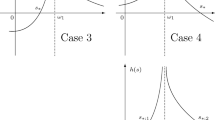Abstract
We identify a class of Linear Complementarity Problems (LCPs) that are solvable in strongly polynomial time by Lemke’s Algorithm (Scheme 1) or by the Parametric Principal Pivoting Method (PPPM). This algorithmic feature for the class of problems under consideration here is attributable to the proper selection of the covering vector in Scheme 1 or the parametric direction vector in the PPPM which leads to solutions of limited and monotonically increasing support size; such solutions are sparse. These and other LCPs may very well have multiple solutions, many of which are unattainable by either algorithm and thus are said to be elusive. The initial conditions imposed on the new matrix class identified in Sect. 2 are subsequently relaxed in later sections.
Similar content being viewed by others
Explore related subjects
Discover the latest articles and news from researchers in related subjects, suggested using machine learning.References
Chandrasekaran, R.: A special case of the complementary pivot problem. Opsearch 7, 263–268 (1970)
Chandrasekaran, R., Kabadi, S.N.: Strongly polynomial algorithm for a class of combinatorial LCPs. Op. Res. Lett. 6, 91–92 (1987)
Chu, T.H.: A class of polynomially solvable linear complementarity problems. Math. Progr. 107, 461–470 (2006)
Chung, S.J.: NP-completeness of the linear complementarity problem. J. Optim. Theory Appl. 60, 393–399 (1989)
Cottle, R.W.: Observations on a class of nasty linear complementarity problems. Discret. Appl. Math. 2, 89–111 (1980)
Cottle, R.W., Dantzig, G.B.: Complementary pivot theory of mathematical programming. Linear Algebra Appl. 1, 103–125 (1968)
Cottle, R.W., Pang, J.-S., Stone, R.E.: The Linear Complementarity Problem. Academic Press, Boston, 1992. [See the revised edition in the Classics in Applied Mathematics series, Philadelphia: SIAM, 2009.]
Cottle, R.W., Stone, R.E.: On the uniqueness of solutions to linear complementarity problems. Math. Progr. 27, 191–213 (1983)
Eaves, B.C.: The linear complementarity problem. Manag. Sci. 17, 612–634 (1971)
Fathi, Y.: Computational complexity of LCPs associated with positive definite symmetric matrices. Math. Progr. 17, 335–344 (1979)
Gana, A.: Studies in the complementarity problem. Ph.D. thesis, Department of Industrial and Operations Engineering, University of Michigan, Ann Arbor
Kelly, L.M., Murty, K.G., Watson, L.T.: CP rays in simplicial cones. Math. Progr. 48, 387–414 (1990)
Klee, V., Minty, G.J.: How good is the simplex algorithm? In: Shisha, O. (ed.) Inequalities—III, pp. 159–175. Academic Press, New York (1972)
Lemke, C.E.: Bimatrix equilibrium points and mathematical programming. Manag. Sci. 11, 681–689 (1965)
Morris Jr., W.D., Lawrence, J.: Geometric properties of Hidden Minkowski matrices. SIAM J. Matrix Anal. Appl. 10, 229–232 (1989)
Murty, K.G.: Computational complexity of complementary pivot methods. Math. Progr. Study 7, 61–73 (1978)
Pang, J.S., Chandrasekaran, R.: Linear complementarity problems solvable by a polynomially bounded pivoting algorithm. Math. Progr. Study 25, 13–27 (1985)
Saigal, R.: A note on a special linear complementarity problem. Opsearch 7, 175–183 (1970)
Schiro, D.A., Pang, J.S., Shanbhag, U.V.: On the solution of affine generalized Nash equilibrium problems with shared constraints by Lemke’s method. Math. Progr., Ser. A 146, 1–46 (2013)
Acknowledgments
The authors are grateful to two referees who have made some constructive comments that have helped to improve the presentation of the paper.
Author information
Authors and Affiliations
Corresponding author
Additional information
J.-S. Pang: The work of this author is based on research supported by the National Science Foundation under grants CMMI 1402052 and 0969600.
Part of this work was done while the authors were visiting the Institute for Mathematical Sciences at the National University of Singapore.
Rights and permissions
About this article
Cite this article
Adler, I., Cottle, R.W. & Pang, JS. Some LCPs solvable in strongly polynomial time with Lemke’s algorithm. Math. Program. 160, 477–493 (2016). https://doi.org/10.1007/s10107-016-0996-4
Received:
Accepted:
Published:
Issue Date:
DOI: https://doi.org/10.1007/s10107-016-0996-4




